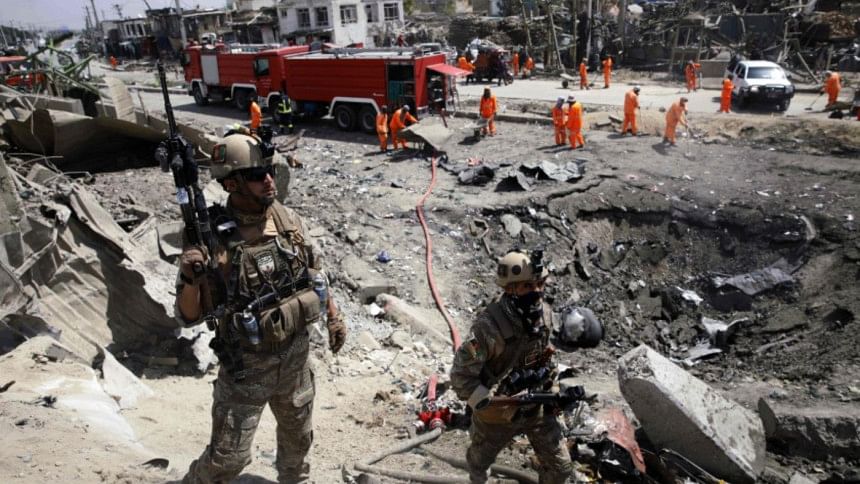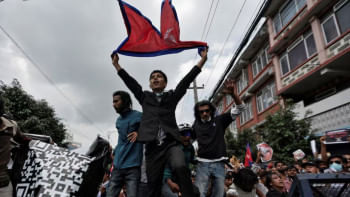Donald Trump’s Afghanistan Strategy

In a self-styled twitter message, on September 8, 2019, US President Donald Trump claimed he had cancelled a secret talk with the Taliban leaders and Afghan President Ashraf Ghani that was due to be held at the historic Camp David presidential retreat. Trump also tweeted that his decision came in response to a recent terrorist attack in Kabul that killed 11 people including a US soldier.
Media pundits opine that the attack was part of a negotiating strategy of the Taliban leaders, who preferred a bilateral deal with the United States first, before working out an intra-Afghan reconciliation process with the incumbent Afghan government. But the Trump administration was insistent on a trilateral deal that would allow the United States to withdraw more than one-third of 14,000 US troops from Afghanistan in less than six months in exchange for release of Taliban prisoners in Afghanistan and Taliban's assurance for counterterrorism cooperation.
The tweet from US president raises two questions for students of security studies: is Trump's effort to negotiate with the Taliban a cheap tactic for improving his approval rate or part of a much larger counterterrorism strategy in Afghanistan? How much does Trump's strategy in Afghanistan resemble the strategies pursued by his two immediate predecessors—George W Bush and Barack Obama?
Despite the familiar characterisation of Trump as an inexperienced dealmaker in foreign policy, Trump appears to be quite serious about secret talks with the Taliban, partly because he would like to capitalise on this for boosting up his re-election possibility; and partly for concentrating on America's geopolitical competition with China and Russia.
This is precisely why in September 2018 he appointed Zalmay Khalilzad, an Afghan-born American diplomat, to serve as a special envoy on Afghanistan. Over the past year, Khalilzad facilitated nine rounds of negotiations in Qatar with the senior Taliban leaders to establish peace and reconciliation in Afghanistan. The negotiations have so far focused on four issues: Taliban assurance that Afghanistan would not be used again as a terrorist sanctuary; complete withdrawal of US and NATO forces; intra-Afghan reconciliation; and a permanent ceasefire.
Trump's efforts to talk with the Taliban may seem by many as an aberration because when in 2012 the Obama regime planned for secret negotiations with the Taliban, Trump did not hesitate to criticise the move. However, a careful reading of Trump's Afghanistan and South Asia strategy, unveiled in August 2017 at a major foreign policy speech delivered from Fort Myer military base, clearly indicates that he had considered dialogue with Taliban to complement US military strategy in Afghanistan.
At Fort Myer, Trump highlighted three pillars of US strategy in Afghanistan: (a) conditions-based troops withdrawal; (b) comprehensive strategy comprising diplomatic, economic, and military power; and (c) changing US approach to dealing with Pakistan. In explaining his second pillar, he noted that "Someday, after an effective military effort, perhaps it will be possible to have a political settlement that includes elements of the Taliban in Afghanistan, but nobody knows if or when that will ever happen."
Trump's three-pillar Afghanistan strategy marks a departure from Obama's counterterrorism strategy in Afghanistan in several ways. First, Trump has repeatedly criticised Obama's decisions on a time-bound exit strategy, and it is hardly surprising that his administration talks about troops withdrawal contingent on improvements in security conditions. Second, in a major policy shift, Trump has also prioritised direct negotiations with the Taliban, something Obama regime did not consider very seriously fearing public backlash and assessing the risk factors. Third, Obama's Af-Pak strategy recognised the value of Pakistan's military offensives in the tribal areas bordering Afghanistan and made strategic dialogue with Pakistan to achieve significant progress in Afghanistan.
Trump departs from Obama's policy by tilting the balance in favour of India: he condemned Pakistan for playing a dangerous double game by extending support for violent extremists which target the US and coalition forces in Afghanistan. In the end, Trump called for abandoning Pakistan and building strategic partnership with India.
Despite these divergences, Obama and Trump appear to converge on the points that they both inherited a "long war" and wanted a rapid exit strategy. Yet, they were convinced to increase the troop level—under Obama presidency, US troops level almost doubled up from 60,000 to 110,000. Although Trump did not order an Obama-style big troop surge, he did authorise the deployment of an additional 4,000 troops making the total US troop level in Afghanistan 14,000.
Despite ordering a small troop increase, Trump has revived an old debate, first confronted by the George W Bush administration, when it started the Afghanistan War in October 2001 and toppled the Taliban regime by December 2001. The debate concerns whether the US should focus only on a narrow counterterrorism strategy or venture into a much ambitious nation-building task. This question has real life implications for the US military forces and the diplomatic community.
Counter-terrorism is an enemy-centric strategy focusing primarily on capturing or killing terrorists, whereas nation-building is a population-centric strategy that privileges securing population centres and long-term investment in infrastructures and institutions. The first requires a small military footprint and limited resources whereas the second requires a large military footprint and huge resources.
Trump has decisively chosen the first and least-cost option, and whether it will produce the desired outcome in the form of a military victory remains a big question. At Fort Myer he wanted to re-assure the American public: "We are not nation-building again. We are killing terrorists." This is absolutely why there is little chance for the United States to increase its troops level in Afghanistan by reversing the course. This is primarily because the expansion of the American troops' mandate in Afghanistan from counterterrorism to counterinsurgency to nation building has already cost a trillion dollars, and 2,450 soldiers in the past eighteen years. A further troop surge would put the burden on to the shoulders of American taxpayers.
As the United States observed the 9/11 anniversary, military commanders in Afghanistan confronted some stark realities about the threat dynamics: Taliban militias now control more than half of Afghan territory, a few hundred al Qaeda terrorists are still active in the country, and the Islamic State Khorasan is seeking to expand its support base in Afghanistan.
Leaving Afghanistan at the mercy of the Taliban may not lend the United States an effective exit strategy. An Afghan power-sharing deal must be complemented by engagement of regional actors like India and Pakistan, and long-term support of the international community. The enemy-centric counterterrorism strategy also needs to be replaced by a larger post-conflict reconstruction process designed and managed by the Afghan people.
ASM Ali Ashraf is Professor of International Relations at the University of Dhaka. He is a member of the International Institute for Strategic Studies, London.

 For all latest news, follow The Daily Star's Google News channel.
For all latest news, follow The Daily Star's Google News channel. 



Comments